
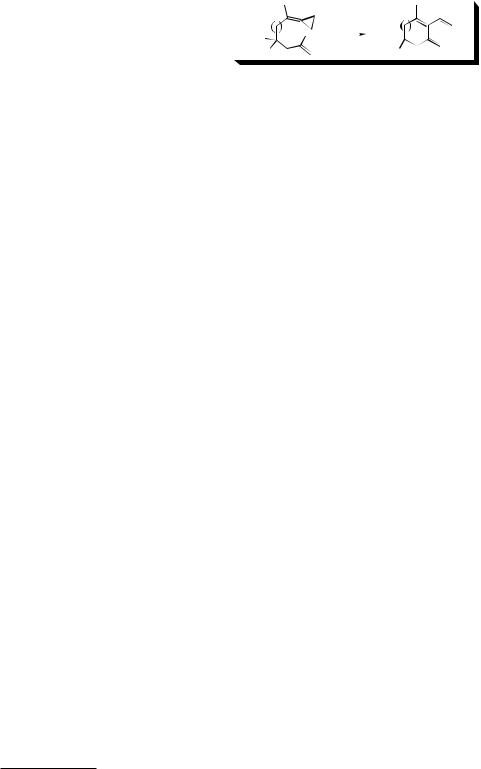
E |
n |
Br |
Pd0 |
n |
|
|
|
|
E |
||
|
|
|
|||
E |
|
|
|
|
E |
IV.3 Palladium-Catalyzed Tandem
and Cascade Carbopalladation of
Alkynes and 1,1-Disubstituted Alkenes
IV.3.1 Palladium-Catalyzed Cascade Carbopalladation: Termination with Alkenes, Arenes, and Related -Bond Systems
STEFAN BRÄSE and ARMIN DE MEIJERE
A. INTRODUCTION
Domino or cascade reactions provide valuable approaches, especially to various carboand heterocyclic systems with three, four, or even more annelated rings. The Heck reaction has successfully been employed in various inter–inter-, intra–inter-, inter–intra-, as well as allintramolecular reaction cascades. In this section, the termination of these processes by alkenes, arenes, and related -bond systems such as alkynes and allenes will be described. A cascade Heck reaction is considered to consist of an oxidative addition of a heteroatom– carbon bond to palladium (starter), carbopalladation of a nonaromatic carbon–carbon double or triple bond without immediate dehydropalladation (relay), one, two, or more further carbopalladation(s) of a carbon–carbon double or triple bond, and eventually ensuing dehydropalladation. Crucial for a cascade reaction of this kind to occur is the blockage or retardation of a dehydropalladation at one of the intermediate stages by using 1,1-disubsti- tuted alkenes and appropriately substituted cycloalkenes, bicycloalkenes, or alkynes as relays since they give kinetically stable alkylor alkenylpalladium intermediates, respectively.
B. INTER–INTRAMOLECULAR CASCADE CARBOPALLADATIONS
B.i. Termination by Alkenes
Five-membered ring closure has been observed when o-halostyrene derivatives were coupled with alkenes under palladium catalysis.[1] Apparently an intramolecular carbopalladation
Handbook of Organopalladium Chemistry for Organic Synthesis, Edited by Ei-ichi Negishi ISBN 0-471-31506-0 © 2002 John Wiley & Sons, Inc.
1369
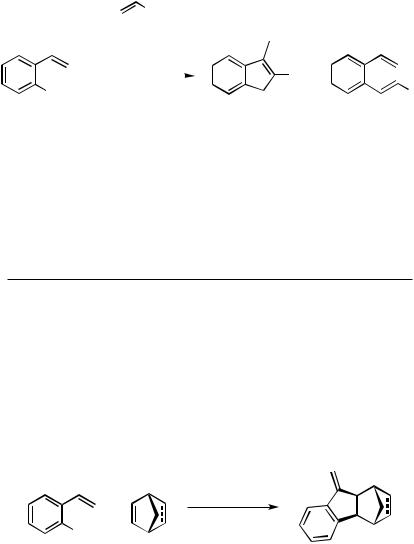
1370 |
IV Pd-CATALYZED REACTIONS INVOLVING CARBOPALLADATION |
with 5-exo-trig ring closure can favorably compete with -hydride elimination in the intermediate -(o-ethenylphenyl)ethylpalladium halide. This reaction mode for the halostyrene is observed especially under Jeffery conditions when the alkene is ethene, propene, or an alkenyl ether (R H, Me or OR) (Scheme 1).[1] Under the same conditions, however, o-dibromoben- zene gives very high yields of o-dialkenylbenzene derivatives (see Sect. IV.2.1).[2],[3]
|
|
R |
|
|
|
|
|
|
|
|
|
Pd(OAc)2 |
|
|
|
|
|
|
|
|
|
K2CO3 or KHCO3 |
|
|
|
|
|
|
|
|
|
LiCl, Bu4NCl, DMF |
|
|
|
|
|
|
|
|
|
80−100 °C |
|
|
R |
+ |
|
|
|
|
|
|
|
|
|||||
|
|
R = H, Me, Ph, OEt |
|
|
R |
||||
|
|
|
|
|
|
||||
|
Br |
|
|
|
|
||||
|
|
|
|
|
Yield (%) |
|
|
Yield (%) |
|
R |
Base, Temperature |
|
Indene |
Dialkenylarene |
|||||
|
|
|
|
|
|||||
H |
KHCO3, 100 °C |
59 |
12 |
|
|||||
Me |
KHCO3, 100 °C |
13 |
38 |
|
|||||
Ph |
KHCO3, 100 °C |
|
2(53)a |
12 |
|
||||
OEt |
K2CO3, 80 °C |
|
49(9)b |
0 |
|
||||
aMixture of double bond isomers.
bMixture of regioisomers.
Scheme 1
When the carbopalladated relay is less prone to undergo -hydride elimination (as, e.g., a corbopalladated methylenecyclopropane moiety) or the -hydride elimination is even completely blocked [as, e.g., an alkyne, norbornene (Scheme 2)[4], or acenaphthylene (Scheme 3)] and the respective cyclopentannelation products can be isolated in moderate to good yields (Scheme 3).[5]
Pd(PPh3)4, KOAc
PhOMe, 80 °C, 6 h
+ |
72−75% |
|
Br
Scheme 2
Yet another type of cyclization was observed for o-bromostilbenes, which actually competes with the second coupling step of o-dibromobenzene with styrene when only 1 equiv of styrene is used. o-Bromostilbene and substituted analogs, prepared from o-bromobenzaldehydes by Wittig–Horner–Emmons olefinations, undergo efficient
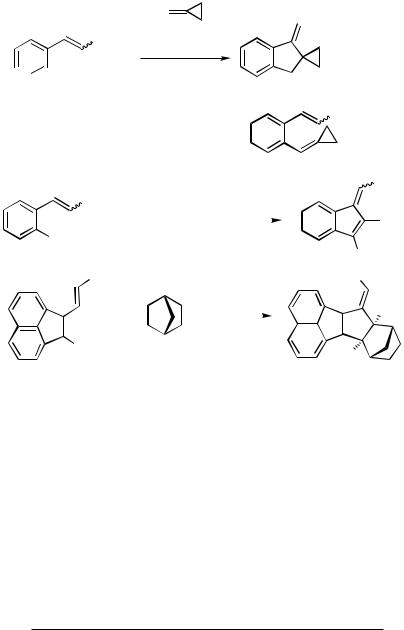
IV.3.1 CASCADE CARBOPALLADATION: TERMINATION WITH ALKENES |
1371 |
 CO2Me
CO2Me
CO2Me Pd(OAc)2, PPh3
K2CO3, Et4NCl

 I
I
|
|
|
|
|
|
|
|
30% (Z/E =5:1) |
|||||||
|
|
|
|
|
|
|
|
|
|
|
|
|
|
CO2Me |
|
|
|
|
+ |
|
32% (E/Z =5:1) |
||||||||||
|
|
|
|
||||||||||||
|
|
|
|
||||||||||||
|
|
|
|
|
|
|
|
|
|
||||||
|
|
|
|
Ph |
|
|
CO2Me |
||||||||
|
CO2Me |
|
|
|
|
|
Pd(OAc)2, KOAc |
|
|
|
|||||
|
+ |
|
|
|
|
PhOMe, 120 °C, 18 h |
|
|
Ph |
||||||
|
|
|
|
|
|
|
|
||||||||
I |
|
|
|
|
|
80% (Z/E = 5:1) |
|
|
|
||||||
|
|
|
|
|
|
|
|
||||||||
|
|
Ph |
|
|
Ph |
||||||||||
|
|
|
|
|
|
||||||||||
|
|
|
|
|
|
|
|
|
|
|
|
|
|
|
|
|
CO2Me |
|
|
|
|
|
|
Pd(OAc)2, PPh3, |
|
MeO2C |
|||||
|
|
|
|
|
|
|
|
TlOAc, MeCN |
|
|
|
||||
|
|
+ |
|
|
|
|
|
reflux |
|
|
|
H |
|||
|
|
|
|
|
|||||||||||
|
|
|
|
62% |
|
|
|
|
|
|
|
||||
|
|
|
|
|
|
|
|
|
|
|
|||||
|
|
|
|
|
|
|
|
|
|
|
|
|
|
|
|
Br
H
Scheme 3
dehydrobrominative cyclodimerization to (E/Z )-9,10-dibenzylidene-9,10-dihydroan- thracenes (Table 1). The (Z )-diastereomers of the parent compound—characterized by an X-ray crystal structure analysis—and its dimethyl derivative preferentially crystallize from the crude mixtures, while the (E )-diastereomers could never be obtained pure in crystalline form. When heated to over 120 °C in solution, the (Z )-form isomerizes to the (E )-form and back (Scheme 4).[6]
Carbopalladation by an arylpalladium iodide across the triple bond of a 1,6-enyne with a methylenecyclopropane terminus under Heck conditions led to a phenyl-substituted cross-conjugated triene (a so-called dendralene) along with terminally phenylated enyne (Scheme 5).[7]
TABLE 1. Inter – Intramolecular Cascade Heck Reaction to Form 9,10-Dibenzylidenedihydroanthracenes (for Details See Scheme 4)
Y |
X |
Yield (%) |
E / Z |
|
|
|
|
H |
H |
80 |
2.9:1 |
Me |
H |
75 |
1:2 |
OMe |
H |
70 |
1:2 |
CO2Me |
H |
72 |
1:1 |
NO2 |
H |
56 |
1.8:1 |
H |
CO2Et |
78 |
1:1 |
OMe |
CO2Et |
64 |
1:1 |
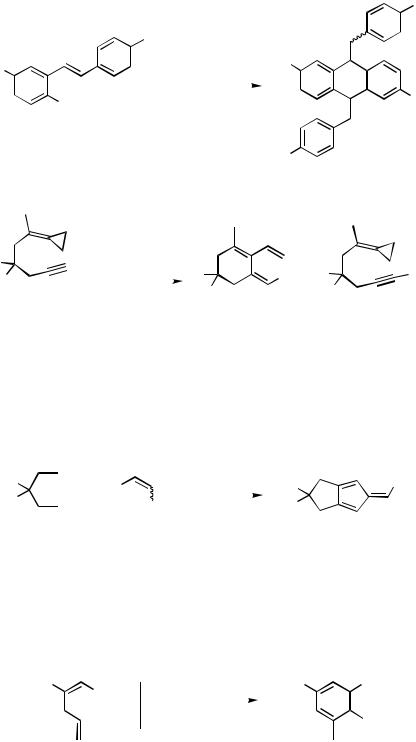
1372 |
IV Pd-CATALYZED REACTIONS INVOLVING CARBOPALLADATION |
|||||||||
|
|
|
|
|
|
|
|
|
|
Y |
|
|
|
Y |
|
|
|
|
|
|
|
|
|
|
|
|
|
|
|
|
||
|
|
|
|
|
|
|
|
|
||
|
|
|
|
Pd(OAc)2, K2CO3 |
X |
|
|
|
||
|
|
|
|
|
|
|
||||
X |
|
|
|
Bu4NCl, LiCl |
|
|
||||
|
|
|
|
|
|
|||||
|
|
|
|
DMF, 100 °C, 15 h |
|
|
|
|
|
|
|
|
|
|
|
|
|
|
|||
|
|
|
|
|
|
|
|
|||
|
|
|
|
|
|
|
|
|
|
|
|
|
|
|
56−80% |
|
|
|
|
|
X |
|
|
|
|
|
|
|
||||
|
|
Br |
|
|
|
|
|
|||
|
|
|
|
|
|
|||||
|
|
|
|
|
|
|
|
|||
|
|
|
|
|
|
|
|
|
|
|
Y
Scheme 4
|
|
PhI, Pd(OAc)2 |
|
|
|
E |
|
PPh3, Et3N |
|
Ph + E |
|
|
E |
DMF, 100 °C, 12 h |
E |
Ph |
|
|
|
E |
|
E |
|
|
|
|
|
||
|
|
E = CO2Me |
45% |
|
42% |
Scheme 5
An inter–intra–intermolecular cascade coupling of a 1,6-diyne with (E )- or (Z )- - bromostyrene led to five-membered ring-annelated fulvenes (Scheme 6).[8],[9] As in many other cases with a formal [2 2 2] assembly using a terminal alkyne as terminator, the six-membered ring was not observed.
|
|
|
|
Pd(PPh3)2Cl2, |
|
|
|
|
|
|
|
Et3N, MeCN |
|
|
|
|
|
|
|
|
|
||
E |
|
|
Ph |
||||
Ph |
60−65 °C, 12 h |
E |
|||||
+ |
|
||||||
E |
|
|
Br |
52% |
E |
|
|
|
|
|
|
||||
|
|
|
|
||||
|
|
|
|
|
|||
|
|
|
(E) or (Z ) |
|
E = CO2Et |
|
|
Scheme 6
However, highly substituted arenes are attainable from iododienes and alkynes with a high degree of regioselectivity (Scheme 7).[10] Apparently, the primarily formed trienes rearrange to the aromatic system.
|
C6H13 |
Pd(PPh3)4 |
|
|
||
|
Et3N, MeCN |
C6H13 |
C6H13 |
|||
C6H13 |
100 °C, 6 d |
|||||
I |
|
|
|
|
||
|
|
|
|
|||
+ |
|
|
65% |
|
|
|
|
|
|
|
|
|
|
SiMe3
SiMe3
Scheme 7
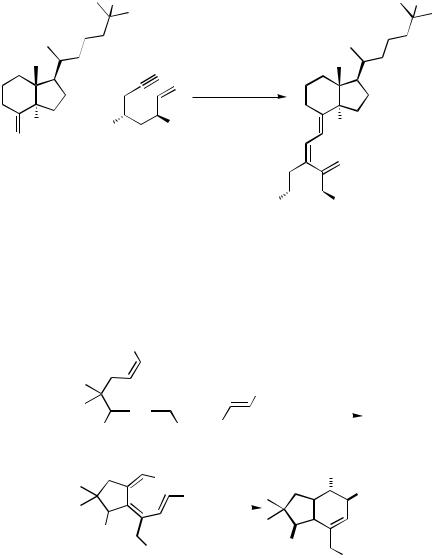
IV.3.1 CASCADE CARBOPALLADATION: TERMINATION WITH ALKENES |
1373 |
An inter – intramolecular cascade starting with a bromoalkene and a 1,7-enyne was developed as an elegant access to calcitriol (Scheme 8).[11],[12]
OH |
OH |
1. “Pd”
PPh3, Et3N PhMe, refl., 2 h
2. n-Bu4NF,
THF, 3 h
+
|
|
|
52% |
H |
RO |
OR |
H |
Br
R = SiMe2t-Bu “Pd” = [Pd2(dba)3 CHCl3]
HO  OH
OH
Scheme 8
A similar assembly starting with -bromostyrene and a 1,6-enyne gave rise to a fivemembered ring-annelated cyclohexadiene formed by a subsequent 6 -electrocyclization of the intermediate (E,Z,Z )-configurated 1,3,5-hexatriene. The disrotatory electrocyclization placed the two substituents on opposite sides of the six-membered ring (Scheme 9).[13]
E
|
|
|
|
|
|
|
|
Ph |
Pd(OAc)2, PPh3 |
||
|
|
|
|
|
|
|
|
Et3N, PhMe |
|||
|
|
|
+ |
|
|
|
|
||||
|
|
|
Br |
|
|
reflux, 4 h |
|||||
|
|
|
|
|
|||||||
|
|
|
|
|
|
|
|
|
|
||
TBDMSO |
|
OMe |
|
|
71% |
|
|||||
|
|
|
|
|
|
|
|
||||
|
|
|
|
|
|
|
|
|
E = CO2Me |
||
|
|
|
|
|
|
|
|
|
|
E |
|
|
|
|
E |
|
|
|
|
|
|||
|
|
|
|
|
|
|
|
|
Ph |
||
|
|
|
Ph |
|
|
|
|
|
|
||
|
|
|
|
|
|
|
|
|
|
||
|
TBDMSO |
|
|
|
|
|
|
|
|
|
|
|
|
|
|
|
|
|
|
|
|
|
|
|
|
|
|
|
|
|
|
|
|
|
|
|
|
OMe |
|
|
TBDMSO |
||||||
|
|
|
|
|
|
|
OMe |
||||
|
|
|
|
|
|
|
|
|
|
||
|
|
|
Scheme 9 |
|
|
|
|
|
|||
2-Substituted 1,6-enynes react with iodobenzene and p-nitroiodobenzene according to a different pattern. After the interand subsequent intramolecular carbopalladation, the palladium residue ends up in a neopentyl position with a , double bond. An ensuing 3-exo-trig carbopalladation then leads to a cyclopropylcarbinylpalladium halide that can undergo rearrangement with subsequent -hydride elimination to yield a benzylidenecyclohexene or direct -hydride elimination to give a bicyclo[3.1.0]hexane derivative (Scheme 10).[14]
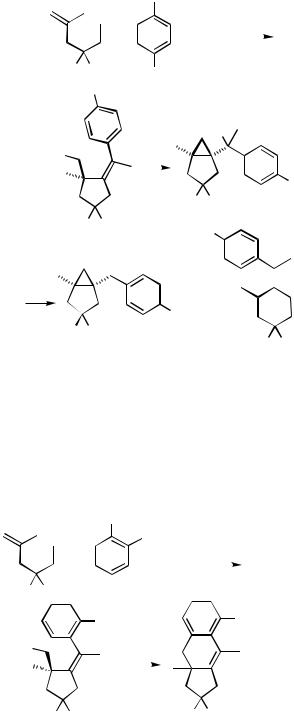
1374 |
IV Pd-CATALYZED REACTIONS INVOLVING CARBOPALLADATION |
|||||||||||||||
|
|
|
|
|
|
|
|
|
|
R |
||||||
|
|
|
|
|
|
|
|
|
|
|||||||
|
|
|
|
|
|
|
|
|
|
|
|
Pd(OAc)2, PPh3 |
||||
|
|
|
|
|
|
|
|
|
|
|
|
|||||
|
|
|
|
|
|
|
|
+ |
|
|
|
K2CO3, DMF |
|
|||
|
|
|
|
|
|
|
|
|
||||||||
|
|
|
|
|
|
|
|
|
|
|
E = CO2Et |
|||||
|
|
|
|
|
|
|
|
|
|
|
|
|||||
|
|
|
E |
E |
|
|
|
|
|
|
R = H, NO2 |
|||||
|
|
|
|
|
|
|
I |
|||||||||
|
|
|
|
|
|
|
|
|
|
|||||||
|
|
|
R |
|
|
|
|
|
|
|
|
|
|
|
||
|
|
|
|
|
|
|
|
|
L2PdI |
|
||||||
|
|
|
I |
|
|
|
|
|
|
|
|
|
||||
|
|
|
|
|
|
|
|
|
|
|
|
|
|
|
|
|
|
|
L2Pd |
|
|
|
|
|
|
|
|
|
|
R |
|
||
|
|
|
|
|
|
|
|
|
|
|
|
|||||
|
|
|
|
|
|
|
|
|
|
|
|
|
|
|
||
|
|
|
|
|
|
|
|
|
|
|
E E |
|
||||
|
|
|
E |
|
|
E |
|
|
|
|
R |
|
|
|||
|
|
|
|
|
|
|
|
|
|
|
|
|
|
|||
|
|
|
+ |
|
|
|
|
|
|
|
|
|
|
|
|
||
|
|
|
|
|
|
|
||
|
|
|
|
|
|
|
||
|
|
|
|
|
|
|
||
|
|
|
R |
|
|
|
||
|
|
|
|
|
|
|||
E E |
E E |
|||||||
2.5−2.0:1 (yield not reported) |
||||||||
|
|
|
||||||
|
|
Scheme 10 |
|
|
|
|||
B.ii. Termination by Arenes
Remarkably, iodoarenes with electron-withdrawing substituents in the ortho-position and 1-iodonaphthalene react with the same enyne under slightly different conditions with ortho-C—H activation and cyclization to yield trior tetracyclic systems incorporating the aromatic ring (Scheme 11).[14],[15]
|
|
|
|
|
|
|
R |
Pd(OAc)2, PPh3 |
|
|
||||||
|
|
|
|
|
|
|
|
|
I |
|
|
|||||
|
|
|
|
|
|
|
|
|
TlOAc, DMF, |
|
|
|||||
|
|
|
|
|
|
|
|
|
|
|
|
|
||||
+ |
|
|
|
|
|
120 °C, 18 h |
|
|
||||||||
|
|
|
|
|
|
|
|
|
|
|
E = CO2Et |
|
|
|||
|
E E |
|
|
|
|
|
|
|
|
|
|
|||||
|
|
|
|
|
R |
|
|
|
|
|
|
|
R |
R |
% |
|
|
|
|
|
|
|
|
|
|
|
|
|
|||||
|
L |
|
|
|
|
|
|
|
|
|||||||
|
|
|
|
|
|
|
|
|
|
|
||||||
L2Pd |
|
|
|
|
|
|
|
|
NO2 |
60 |
||||||
|
|
|
|
|
|
|
|
|
|
|
|
|
|
|
CN |
54 |
|
|
|
|
|
|
|
|
|
|
|
|
|
|
|
||
|
|
|
|
|
|
|
|
|
|
|
|
|
|
|
CF3 |
68 |
|
|
E E |
|
|
|
|
E E |
|
|
|||||||
Scheme 11
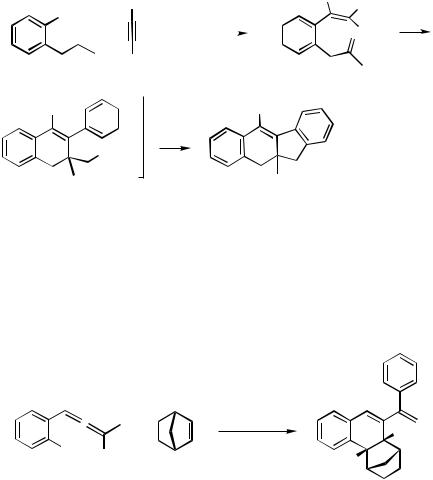
IV.3.1 CASCADE CARBOPALLADATION: TERMINATION WITH ALKENES |
1375 |
The carbopalladation of a triple bond is faster than that of a double bond, even when the alkene is tethered to the initially formed arylpalladium halides. This is exemplified by the formation of a tetracyclic system from o-isobutenyliodobenzene and diphenylethyne. This process is also terminated by ortho attack of the intermediate neopentyl-type alkylpalladium halide on one of the arene rings (Scheme 12).[16]
|
|
|
|
Ph |
Pd(OAc)2, PPh3, |
|
|
|
Ph |
|||
|
|
|
|
|
|
|
Ph |
|||||
I |
|
Tl2CO3 |
|
|
|
|||||||
|
|
|
|
|
||||||||
|
|
+ |
|
|
|
|
130 °C, 20 h |
|
|
|
|
PdIL2 |
|
|
|
|
|
|
|
|
|
||||
|
|
|
Ph |
60% |
|
|
|
|
||||
|
|
|
|
|
|
|
|
|
|
|
||
|
|
|
|
|
|
|
|
|
|
|||
Ph |
|
|
|
|
|
|
Ph |
|||||
|
|
|
|
|
|
|||||||
|
|
|
|
|||||||||
|
|
|
|
|
|
|
|
|
|
|
|
|
PdIL2
Scheme 12
B.iii. Termination by Allenes
Since strained alkenes and cycloalkenes are particularly good ligands for palladium, even an ortho-allenyl-substituted arylpalladium iodide will first carbopalladate a norbornene intermolecularly before the allenyl unit intercepts the relay norbornylpalladium species intramolecularly (Scheme 13).[17]
|
• |
I |
Ph |
|
+
Pd(OAc)2, PPh3, K2CO3, Et4NCl,
MeCN
reflux, 20 h
H
96%
H
Scheme 13
C. INTRA–INTERMOLECULAR CASCADE CARBOPALLADATIONS
Intramolecular carbopalladations usually are fast processes, which are terminated by dehydropalladation unless the carbopalladation leads to an alkenylor neopentylpalladium intermediate, in which cases cascade carbopalladation sequences can be set off with other externally or internally available -systems.
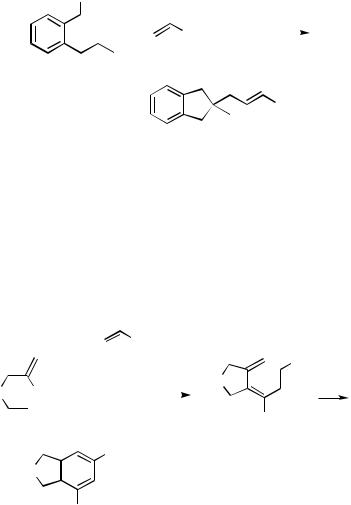
1376 |
IV Pd-CATALYZED REACTIONS INVOLVING CARBOPALLADATION |
C.i. Termination by Alkenes
Alkenes are the most common terminators for intra – intermolecular cascade processes. This is exemplified by the intramolecular benzylpalladation leading to a neopentyl relay with ensuing termination by methyl acrylate yielding a 2,2-disubstituted indane (Scheme 14).[18]
Cl |
|
Pd(PPh3)4, |
|||
|
|
|
|
Et3N, MeCN, |
|
|
|
+ |
CO2Me |
reflux, 2 d |
|
|
|
||||
|
|
|
|
||
|
|||||
|
|
|
55% |
|
|
|
|
|
|
||
CO2Me
Scheme 14
The intramolecular carbopalladation starting from a 2-halo-1,6-enyne leads to a terminal alkenylpalladium halide relay that can be trapped by an external alkene or alkyne. With the former, the cascade process leads to a 1,3,5-hexatriene that undergoes rapid 6 -electrocyclization to a five-ring-annelated cyclohexadiene and this, in turn, is easily dehydrogenated to the corresponding aromatic compound (Scheme 15).[19] With an external alkyne trapping the intermediate, a 1,3,5-hexatrienylpalladium intermediate will be formed and can either cyclize by intramolecular carbopalladation or 6 -electrocycliza- tion before termination by dehydropalladation will occur.[8]
|
|
|
|
|
|
|
CO2Me |
|
|
|
|
|
|
|
|
|
|
|
|
|
Pd(OAc)2, PPh3 |
|
|
|
E |
|
|
|
|
|
|
|
|
|
K2CO3, (AgNO3), |
|
|
X |
|
|
|
X |
|
Br |
MeCN, 110 °C, 3 h |
|
|
|
|
|
|||||
|
|
|
|
|
|
|
|||||||
|
|
|
|
|
|
|
|
||||||
|
14−56% |
|
|
|
|
|
|
||||||
|
|
|
|
|
|
E |
|
|
E |
|
|
|
|
|
|
|
|
|
|
|
|
|
|
|
|||
|
|
|
|
|
|
E = CO2Me |
|
|
|
|
|
||
|
|
|
|
|
|
|
|
||||||
|
|
|
|
|
|
|
|
|
|
|
|
||
|
|
|
|
|
|
|
|
|
X |
% |
|||
|
|
|
|
|
|
|
E |
|
|
||||
|
|
|
|
|
|
|
|
|
|
|
|
|
|
|
X |
|
|
|
|
O |
20 |
||||||
|
|
|
|
|
|||||||||
|
|
|
|
|
|
|
|
|
|
NPh |
14 |
||
|
|
|
|
|
|
E |
|
|
|
C(CO2Me)2 |
56 |
||
Scheme 15
Starting from dimedone, 3-allyl-substituted cyclohexa-1,4-diene-2,4-diyl bisnonafluorobutanesulfonates have been prepared in four efficient steps. These 1,5-hexadienes under palladium catalysis first undergo intramolecular carbopalladation followed by dehydropalladation to yield a 8-methylenebicyclo[4.2.0]octa-1,4-dien derivative, which subsequently couples intermolecularly with added tert-butyl acrylate. In the presence of
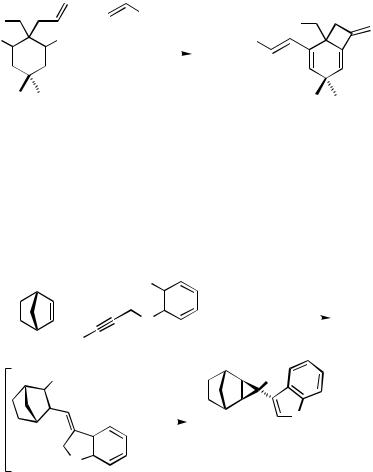
IV.3.1 CASCADE CARBOPALLADATION: TERMINATION WITH ALKENES |
1377 |
(R,R)-BINAP as a chiral ligand, the product was obtained with a moderate enantiomeric excess (up to 53% ee) (Scheme 16).[20]
Ph |
|
CO2t-Bu |
Ph |
||
|
Pd(OAc)2, PPh3 |
||||
NfO |
ONf |
t-BuO2C |
|||
Et3N, DMF |
|||||
|
|
|
|
||
|
|
|
80 °C, 12 h |
|
|
|
|
|
|
||
43%
Nf = C4F9SO2
Scheme 16
Norbornene can serve as an excellent external relay, for example, for the alkenylpalladium species first formed by intramolecular carbopalladation of an ortho-alkynyl- substituted arylpalladium halide. The 2-alkenylnorbonylpalladium halide formed by intermolecular carbopalladation then undergoes another intramolecular carbopalladation, this one in a 3-exo-trig mode, and subsequent -hydride elimination terminates the cascade process to yield a cyclopropanated norbornene derivative (Scheme 17).[21],[22]
|
|
|
I |
|
|
|
|
|
+ |
|
|
|
|
|
|
Pd(OAc)2, PPh3 |
|
|
|
|
|
|
|
|||
|
|
|
X |
|
|
|
MeCN, reflux, 16 h |
|
|
|
|
45% |
|
||||
|
|
|
|
|
||||
R |
|
|
|
|
|
|
|
|
PdIL2 |
|
|
|
|
|
|
R |
|
|
|
|
|
|
|
|
||
|
|
|
|
|
|
|
X |
|
|
|
|
|
|
|
X = O, R = H: |
45% |
|
|
|
|
|
|
|
|||
X |
|
|
|
|
|
X = NAc, R = Me: |
45% |
|
|
|
|
|
|
|
|||
|
|
|
|
|
|
|||
Scheme 17
C.ii. Termination by Arenes
When the ortho-alkynyl tether on the iodoarene bears a terminal aryl group the cascade process after the intra–intermolecular carbopalladation sequence may be terminated by an ortho attack of the norbornylpalladium intermediate on the previously terminal aryl group (cf. Scheme 10) to yield an oligocyclic system (Scheme 18).[22]
C.iii. Termination by Allenes
The intra – intermolecular cascade can also be terminated with an external allene, like 1,1- dimethylallene, leading to a 2,3-disubstituted 1,3-diene that can subsequently be trapped by an added dienophile in a Diels–Alder reaction (Scheme 19).[23]
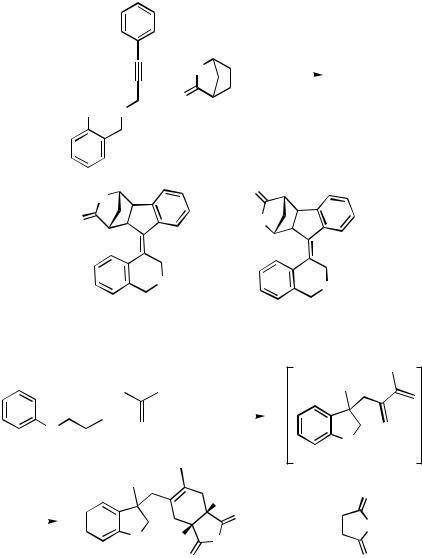
1378 |
IV Pd-CATALYZED REACTIONS INVOLVING CARBOPALLADATION |
|
|
|
Pd(OAc)2, PPh3 |
|
|
|
|
TlOAc, MeCN, |
|
|
BnN |
|
reflux, 2 d |
|
+ |
|
|
70% |
|
O |
|
|||
|
|
|
||
I O
O
BnN
O |
BnN |
|
+ |
O
1:1
Scheme 18
Pd(OAc)2, PPh3
 I Ag2CO3, PhMe,
I Ag2CO3, PhMe,
120 °C, 48 h
|
|
|
+ |
|
|
|
|
|
|
|
|
|
|
R |
|||
N |
|
• |
|
|
||||
|
|
|
|
|
|
|
||
R |
|
|
|
|
|
|
R= SO2Ph: 69% |
|
|
|
|
|
|
|
|
|
R= Me: 72% |
NMMI |
|
|
|
|
|
H |
||
|
|
|
|
|
O |
|||
|
|
|
N |
H |
NMe |
|||
|
|
|
||||||
R
O
Scheme 19
O
|
N |
|
|
R |
|
|
|
O |
NMMI = |
|
NMe |
|
||
|
|
O |
C.iv. Termination by Alkynes
A norbornylpalladium intermediate, for example, generated in an intramolecular carbopalladation, may react with an external terminal alkyne in terms of a simple Csp3 – Csp cross-coupling reaction (Scheme 20).[24]
On the other hand, an alkenylpalladium intermediate formed by intramolecular carbopalladation from a 2-bromo-1-en-6-yne carbopalladates an external monoor disubstituted alkyne, and the cascade process is terminated by cyclization of the 1,3,5-hexatrienylpalladium intermediate through intramolecular carbopalladation or 6 -electrocyclization and ensuing dehydropalladation (Scheme 21).[8],[9],[25]
